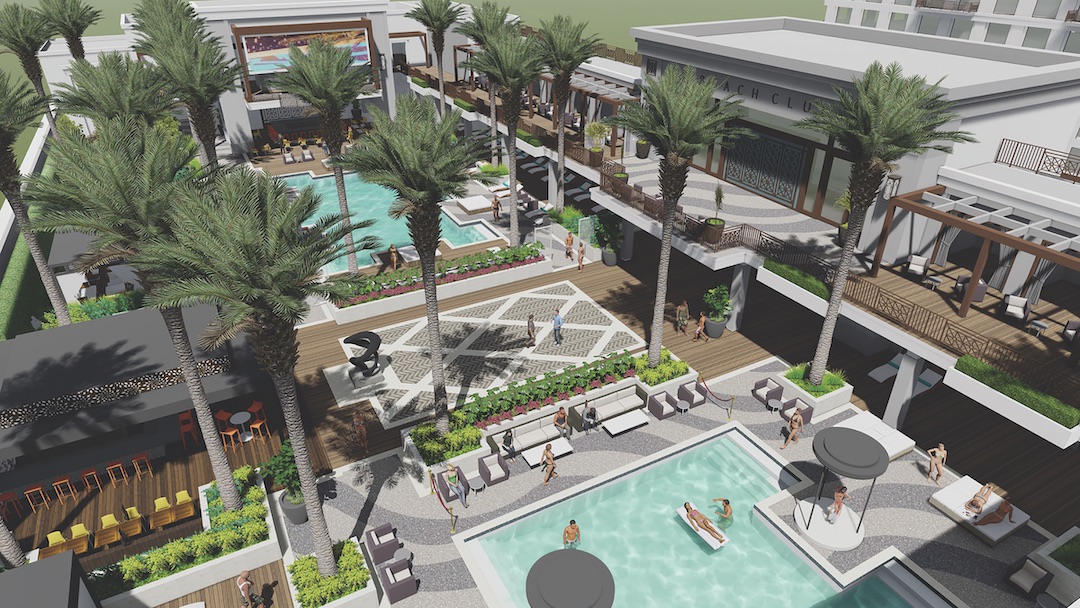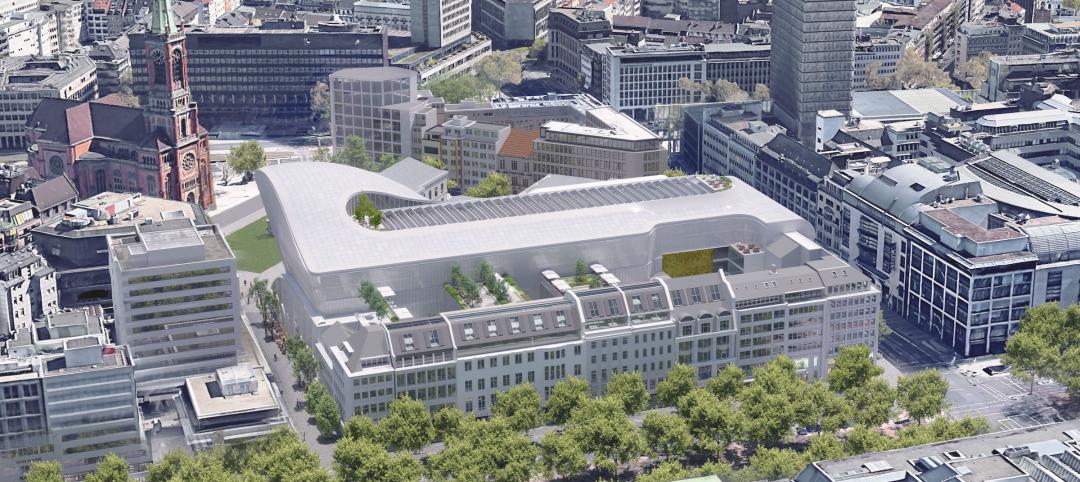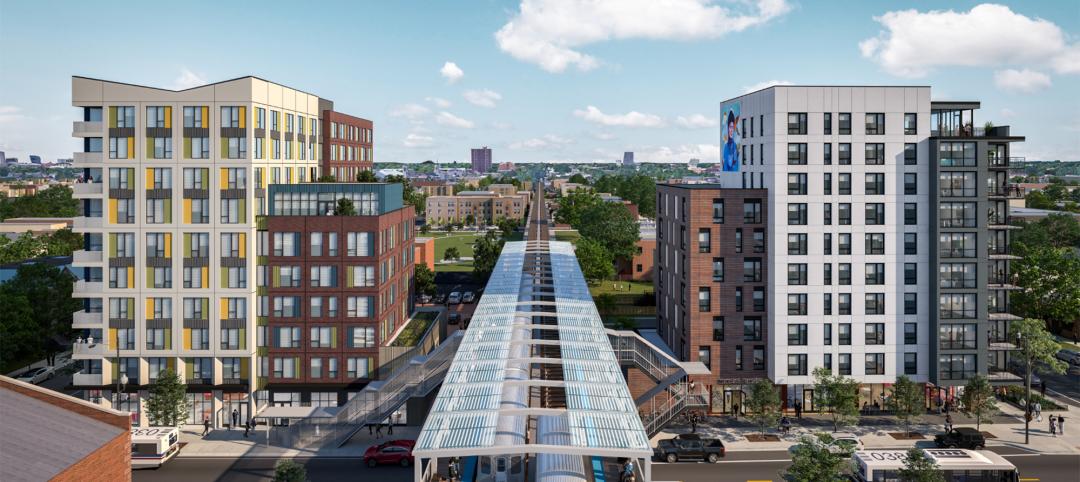During the early months of 2020, construction is scheduled to start in Irvine, Calif., on BANC, a 250-key luxury hotel with 16 condos and 150,000 sf of office space. Sitting atop that building’s parking garage will be a 40,000-sf roof deck with two swimming pools, a 6,500-sf nightclub, and $1.4 million in landscaping.
The landscaping will contribute to providing a level of intimacy for an amenity that accommodates 1,200 people. Another element meant to create “a kind of Las Vegas experience” will be 40 rentable cabanas, including six that fit up to 20 people each, says Rob Budetti, NCARB, CDP, LEED GA, Partner with AO Architects, this project’s designer.
BANC accentuates how roof deck entertainment spaces have become prevalent, even essential, in new construction and as additions to existing buildings. The amenity has become a prominent feature for office buildings, offering “an accessible, secure extension of the occupants’ workplace,” explains John Crump, Vice President and Workplace Studio Leader for SmithGroup’s Washington, D.C., office, whose recent projects include the District Center at 555 12th Street NW, with a 10,000-sf outdoor terrace.
When considering a roof entertainment space, project teams must address several factors: weight loads, moisture control and rainwater management, wind uplift, and occupant safety. The BANC project, for example, must account for the pools’ depth (3½ to 4 feet) and planters with six feet of planting depth, says Diego Alessi, ASLA, Principal and Director of AO Architects’ landscape studio.
There are four types of loads—snow, rain, live, and dead—that any roof deck design manages, says Blair Hildahl, PE, LEED AP, CMO and Founding Partner with Base4, an AE firm based in LaCrosse, Wis. He adds that if shear walls don’t extend above the roof level, the rooftop structure must be able to withstand lateral loads from seismic and wind activity.
“Planning for a roof deck needs to happen at the concept stage,” says Hildahl. “The challenge is to make egress, accessibility, insulation requirements, and waterproofing/drainage work together efficiently.”
That gets complicated when the amenity is being dropped onto an older building whose original structural design only figured on snow and dead loads on the roof.
Chicago-based architecture and construction firm Epstein designed the conversion of the Conrad Chicago from an office building to a hotel. The owner, Lawrence Geller, insisted on adding a dynamic roof, so Epstein had to make sure the building’s columns could handle the extra load. The columns were reinforced with a carbon-fiber spray, and beams were installed under the roof slab, says David Scott, AIA, Epstein’s Director of Hospitality.
Roof deck amenities are typically built in layers, and the lower layers “are probably not going to be touched again for a very long time,” says Craig Hargrove, AIA, LEED AP, CDT, RRC, Senior Vice President and Director of Architecture with Hoffmann Architects. “So how those layers get built is important because they can be fabulously expensive.”
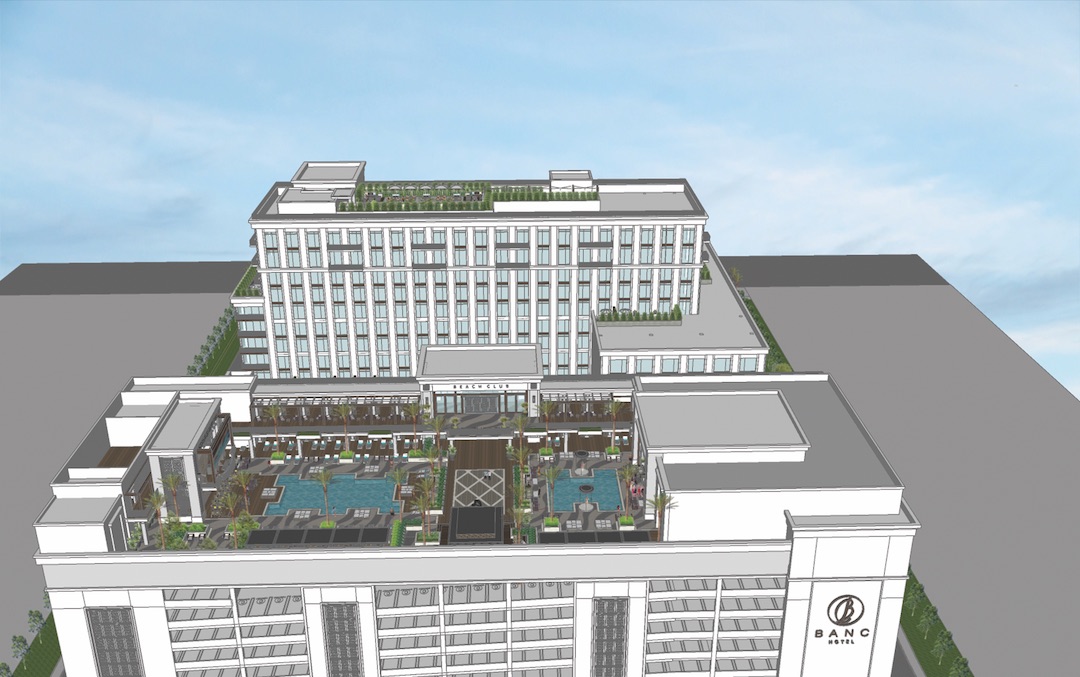
Hargrove notes that a deck must deal with the pitch that funnels rainwater from the roof to drains. But a ½-inch incline in the walking surface “can be noticeable and disturbing psychologically” to people standing on it.
Water can be moved to drains at two levels: at the structural deck where the waterproofing membrane is often installed, and above the deck at the walking surface. If these two surfaces drain independently, each can have two different pitches, allowing the walking surface to have a slope that is more conducive to the use of the space. In other cases, such as with loose laid pavers on a pedestal system over the structural deck, the walking surface can be level with no pitch, because water that might collect at the walking surface will drain to the structural deck between the pavers. The pitch of the roof then moves the water by gravity to the drains.
Another approach—and one that is typically less expensive—is to stack high-density plastic adjustable shims, known as screw jacks, under the corners of the deck to level the panels.
In any reconstruction that involves a roof deck, “it’s important to consider insulation placement,” advises Carl Baldassarra, Principal and Unit Manager with Wiss, Janney, Elstner Associates (WJE). Improper installation below the roof deck can lead to problems such as increased freeze-thaw damage, efflorescence, and condensation.
To control moisture, WJE uses a separate waterproofing membrane, such as hot applied rubberized asphalt, which functions as an air barrier and vapor retarder on the surface of the deck, say WJE Principals Norbert Krogstad and Rich Koziol. (The choice of insulation, says Koziol, is currently confined to extruded polystyrene board because of its water-resistant properties.)
Hargrove of Hoffmann Architects notes that the trick is to keep the roof’s membrane as far away from the asset as possible to protect the membrane, which is a key component in moisture control. Penetration points therefore should be flashed and detailed carefully.
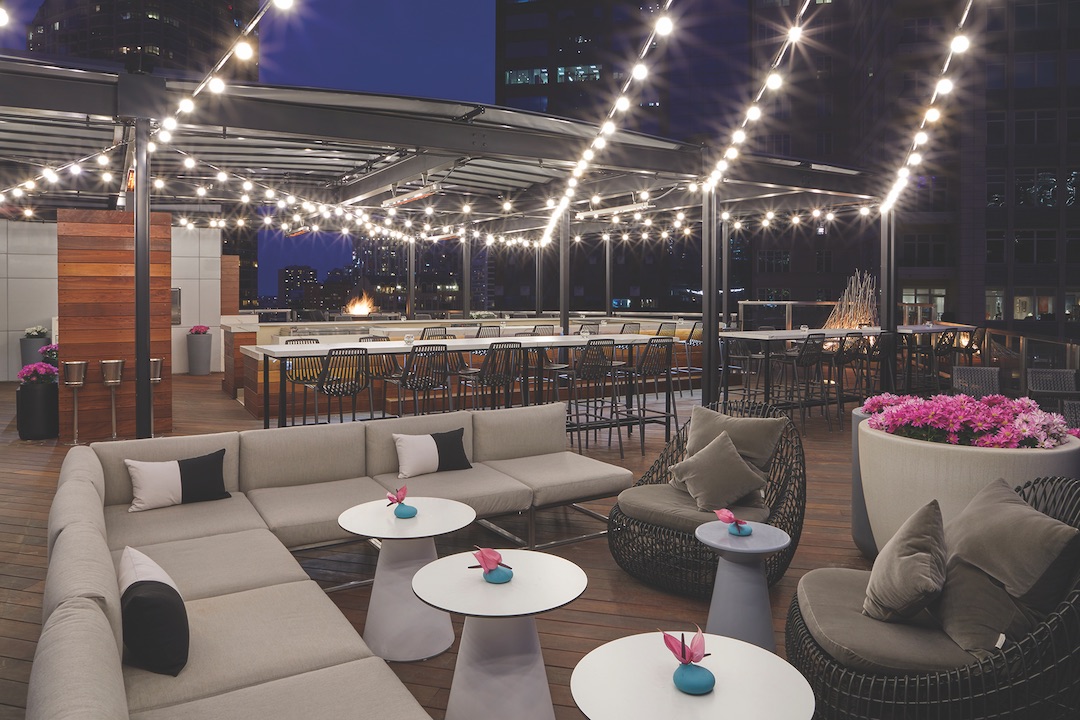 The roof deck amenity atop the Conrad by Hilton hotel in Chicago—an adaptive reuse of an office building—required that the building’s structural columns be reinforced to hold the extra weight. Roof deck amenities must also handle wind lift when installing flooring and furniture. Photo: Neal Burger/courtesy Epstein.
The roof deck amenity atop the Conrad by Hilton hotel in Chicago—an adaptive reuse of an office building—required that the building’s structural columns be reinforced to hold the extra weight. Roof deck amenities must also handle wind lift when installing flooring and furniture. Photo: Neal Burger/courtesy Epstein.
Getting the entertainment space to intersect seamlessly with the roof’s rainwater drainage system is a design imperative. But, Scott cautions, “People don’t want to see what you’re doing to remove water.”
To manage rainwater, BANC’s roof deck amenity will be built on paving materials atop a pedestal-like system that, at different areas, will be between six and 18 inches above the roof. Irrigation and drainage will go through the underdeck space. Planters will have their own drainage system that’s filtered through a biofiltration swale (a requirement in California).
Wind can play havoc on outdoor entertainment spaces. WJE’s Krogstad says that, depending on the space and the height of the building, it might be necessary to anchor the deck or terrace finishes to the structure below. Hargrove points out that manufacturers offer paver-locking systems, in wood or precast concrete, so that the roof itself acts as a large unit of ballast.
See Also: Passive House picks up steam
Base4’s Hildahl notes that the deck height can affect the elevator landing heights. “And if there’s a kitchen or any covered spaces, they need to be raised, too; otherwise you may need a ramp for such spaces.”
The number of exit doors, stairs, sprinklers, standpipes, and elevators that a roof deck entertainment space must have is spelled out in codes that, for an existing building, sometimes lead to reconstruction. “It’s sort of the reverse from the way most buildings are designed” because people are moving back and forth from the top of the building, says Epstein’s Scott. For the Conrad Chicago project, the Building Team had to deconstruct a section of the building to make way for a second stairwell.
In the interest of occupant safety, rooftop spaces used by the public need to be reviewed for guardrail height, says WJE’s Baldassarra. Roof decks on tall buildings might also limit the use of combustible materials such as wood decking.
Related Stories
Urban Planning | Apr 12, 2023
Watch: Trends in urban design for 2023, with James Corner Field Operations
Isabel Castilla, a Principal Designer with the landscape architecture firm James Corner Field Operations, discusses recent changes in clients' priorities about urban design, with a focus on her firm's recent projects.
Market Data | Apr 11, 2023
Construction crane count reaches all-time high in Q1 2023
Toronto, Seattle, Los Angeles, and Denver top the list of U.S/Canadian cities with the greatest number of fixed cranes on construction sites, according to Rider Levett Bucknall's RLB Crane Index for North America for Q1 2023.
Contractors | Apr 10, 2023
What makes prefabrication work? Factors every construction project should consider
There are many factors requiring careful consideration when determining whether a project is a good fit for prefabrication. JE Dunn’s Brian Burkett breaks down the most important considerations.
Mixed-Use | Apr 7, 2023
New Nashville mixed-use high-rise features curved, stepped massing and wellness focus
Construction recently started on 5 City Blvd, a new 15-story office and mixed-use building in Nashville, Tenn. Located on a uniquely shaped site, the 730,000-sf structure features curved, stepped massing and amenities with a focus on wellness.
Affordable Housing | Mar 14, 2023
3 affordable housing projects that overcame building obstacles
These three developments faced certain obstacles during their building processes—from surrounding noise suppression to construction methodology.
Mixed-Use | Mar 11, 2023
Austin mixed-use development will provide two million sf of office, retail, and residential space
In Austin, Texas, the seven-building East Riverside Gateway complex will provide a mixed-use community next to the city’s planned Blue Line light rail, which will connect the Austin Bergstrom International Airport with downtown Austin. Planned and designed by Steinberg Hart, the development will include over 2 million sf of office, retail, and residential space, as well as amenities, such as a large park, that are intended to draw tech workers and young families.
Sports and Recreational Facilities | Feb 27, 2023
New 20,000-seat soccer stadium will anchor neighborhood development in Indianapolis
A new 20,000-seat soccer stadium for United Soccer League’s Indy Eleven will be the centerpiece of a major neighborhood development in Indianapolis. The development will transform the southwest quadrant of downtown Indianapolis by adding more than 600 apartments, 205,000 sf of office space, 197,000 sf for retail space and restaurants, parking garages, a hotel, and public plazas with green space.
Retail Centers | Feb 24, 2023
Santiago Calatrava unveils plans for a luxury retail and office complex in Düsseldorf, Germany
Renowned architect and engineer Santiago Calatrava, along with the CENTRUM Group, has unveiled plans for Calatrava Boulevard, a luxury retail and office complex in Düsseldorf, Germany. Running parallel to Königsallee and connecting with the Steinstrasse station, Calatrava Boulevard will incorporate and connect to the boulevard’s existing buildings.
Mixed-Use | Feb 23, 2023
7 mixed-use developments that don't sacrifice housing affordability
Here are seven mixed-use, multifamily projects dedicated to providing affordable housing.
Multifamily Housing | Feb 21, 2023
Watch: DBA Architects' Bryan Moore talks micro communities and the benefits of walkable neighborhoods
What is a micro-community? Where are they most prevalent? What’s the future for micro communities? These questions (and more) addressed by Bryan Moore, President and CEO of DBA Architects.


